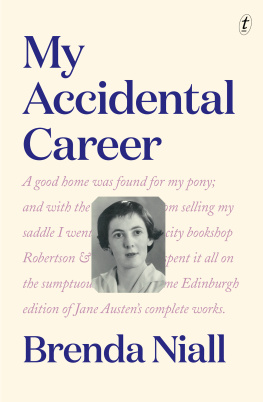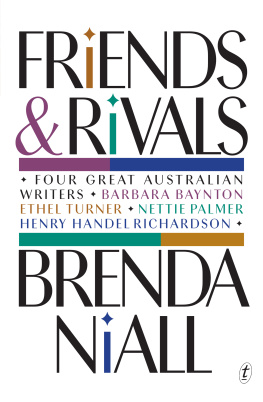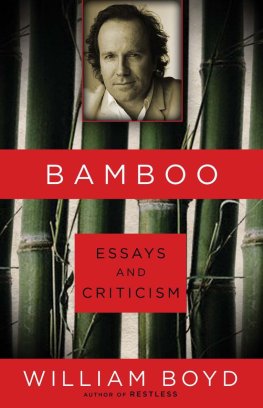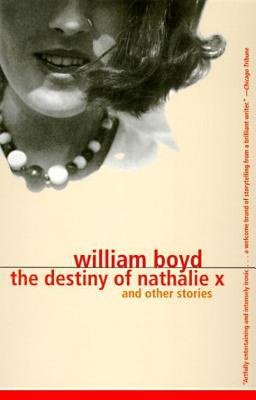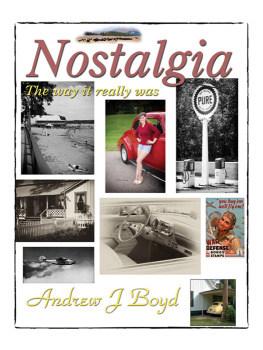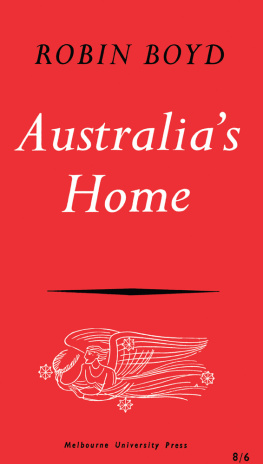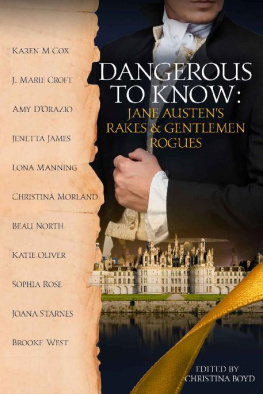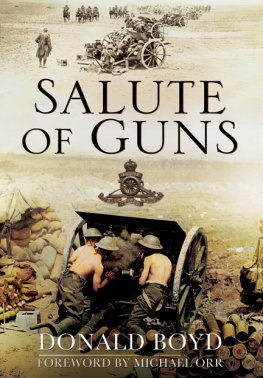BRENDA NIALL ON ARTHUR BOYD
MUP TITLES BY BRENDA NIALL
Georgiana: A biography of Georgiana McCrae, painter, diarist, pioneer
Martin Boyd: A life
The Boyds: A family biography
Brenda Niall
On Arthur Boyd
MELBOURNE UNIVERSITY PRESS
An imprint of Melbourne University Publishing Ltd (MUP Ltd)
187 Grattan Street, Carlton, Victoria 3053, Australia
www.mup.com.au
First published 2005
Text Brenda Niall 2005
Design and typography Melbourne University Publishing Ltd 2005
The Boyds first published 2002
Reprinted 2003
Text Brenda Niall 2002
Design & Typography MUP 2002
This book is copyright. Apart from any use permitted under the Copyright Act 1968 and subsequent amendments, no part may be reproduced, stored in a retrieval system or transmitted by any means or process whatsoever without the prior written permission of the publishers.
Designed by Guy Mirabella
Typeset in Australia by J & M Typesetting
Printed in Australia by Griffin Press
National Library of Australia Cataloguing-in-Publication entry
Niall, Brenda, 1930- .
Brenda Niall on Arthur Boyd
ISBN 0 522 85194 0.
1. Boyd family. 2. Artists - Australia - Biography. 3. Australia - Genealogy. I. Niall, Brenda, 1930- The Boyds : a family biography. II. Title. (Series : MUP masterworks).
709.2294
About this book
The MUP Masterworks series celebrates distinguished Australian writers and ideas. Brenda Niall On Arthur Boyd, the third volume in the series, is drawn from Nialls award-winning study of Australias most remarkable artistic family, The Boyds.
The Boyd dynasty began in 1886, when one talented painter, Emma Minnie Beckett, married another, Arthur Merric Boyd. Since then, Australian painting, sculpture, ceramics, literature, music and architecture have been enriched by Boyd creativity and vision. Of all the gifted family members, the painter Arthur Boyd (192099) achieved the widest fame, partly because like other Australian artists of his generation he spent decades living and working in Europe.
First published in 2002, The Boyds won both the Victorian and Queensland Premiers Awards for Non-Fiction. In this extract from Chapters 15 and 17, Brenda Niall describes how Arthur and his wife Yvonne set out for London in the late 1950s, and explores the life they made there with friends and family the painters Albert Tucker, Sidney Nolan and David Boyd, and the writer Martin Boyd among them. She also traces Arthurs continuing attachment to the Australian landscape, and the places in it that he had known.
In 1979, he purchased Bundanon, a searingly beautiful rural property on the Shoalhaven River in New South Wales, and its country became a favourite subject of his later work. What kindled Arthur Boyds imagination, Niall writes, was something he could see and paint, and if a paintable landscape had a house as a focal point, then the spark was well alight.
Brenda Niall On Arthur Boyd
Rome, July 1 [1957]
Dear Yvonne and Arthur
Wonderful to hear that you all may come to Europe
Butsome of the unpleasant facts of life. You will need bags of money. No matter how good Arthurs painting is Europe will be obstinately blind to it, and he would have to strike very freakish circumstances indeed to make any worthwhile sales. Prices in London are about the same as in Australia, but if I know the fish-souled English at all, they will reject Arthurs painting on sight. They like these sterile, tidy abstracts or milk and piddle landscapes. In France or Italy, prices are a quarter to one fifth Australian. Also the social and cultural life in Europe is incredibly tricky and complexand corrupt. In many ways Australia is a haven of sanity and civilization by comparison. But then perhaps Ive been here too long.
The gloom in Albert Tuckers voice was all his own, but his letter to Arthur and Yvonne Boyd dramatised the fears of many young artists who left Australia in the 1950s. Tuckers message was full of contradictions. Europe was terrifying but also magnificent; the Boyds could not afford it, but they could not do without it; the English would be too ignorant to appreciate Arthurs work; Arthurs work would probably collapse into impotence or confusion. The Boyds might have felt some of these fears, but the one that counted most for them in the 1950s was money. Of course they thought about a move to London but Arthur was more patient and probably more confident than most of his fellow artists. By the mid-1950s it was a question for them all: when to make the break from an art scene that was too small and parochial to satisfy members of an exceptionally talented generation. William Dobell and Russell Drysdale had worked in London before the war. Tucker, who left in 1947, was one of the first of the post-war expatriates. Sidney Nolan had been coming and going to Europe and the United States since 1950. Arthurs brother David, who set off in October 1950 with his wife Hermia and their first child, did well in London, with good sales and reviews. They moved on to the French village of Tourrettes-sur-Loup, where they lived light-heartedly and precariously on twenty-five shillings a week, before going back to London. David wrote early in 1953 urging Arthur to join him, but Arthur, who was then still living at Murrumbeena, was not ready to be persuaded.
The little studio among the trees at his fathers place Open Country, designed by Robin Boyd and built before the war, was Arthurs home for the first eleven years of his marriage. It was not until 1955, when he was in his mid-thirties, that he bought a house of his own. This was partly for lack of moneyhis paintings were not sellingbut also because he could work happily at Murrumbeena, and because the ties with his parents were still strong. It was not the usual dependency on parental strength; his father Merrics frail health and his mother Doriss long-established habit of looking for support to her eldest son made it hard for Arthur to leave them. When he moved, he did not go far. He bought a small weatherboard cottage in Surf Avenue, Beaumaris, on the sea front, and called in his friend the builder John Murphy to turn the garage into a studio. For Arthur, every house was an extended studio and every room had paintings stacked against the walls. His work was the focus of family life.
In later years the Boyds remembered Beaumaris affectionately for the sea and tea-tree and the long stretch of sandy beach just across the road from the house, and for the excitement of Arthurs first big public commission. This was a 30-foot high ceramic totem pole, made up of 260 glazed terracotta bricks, which would stand beside Melbournes new Olympic Pool when for the first time an Australian city was host to the Olympic Games.
A turning point in Arthur Boyds career came in April 1958 when he showed his


